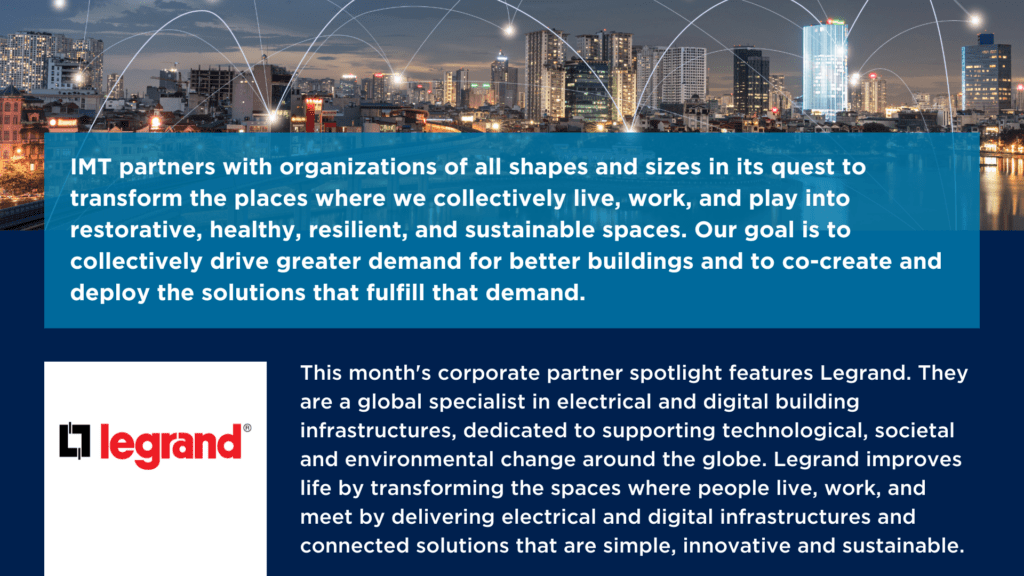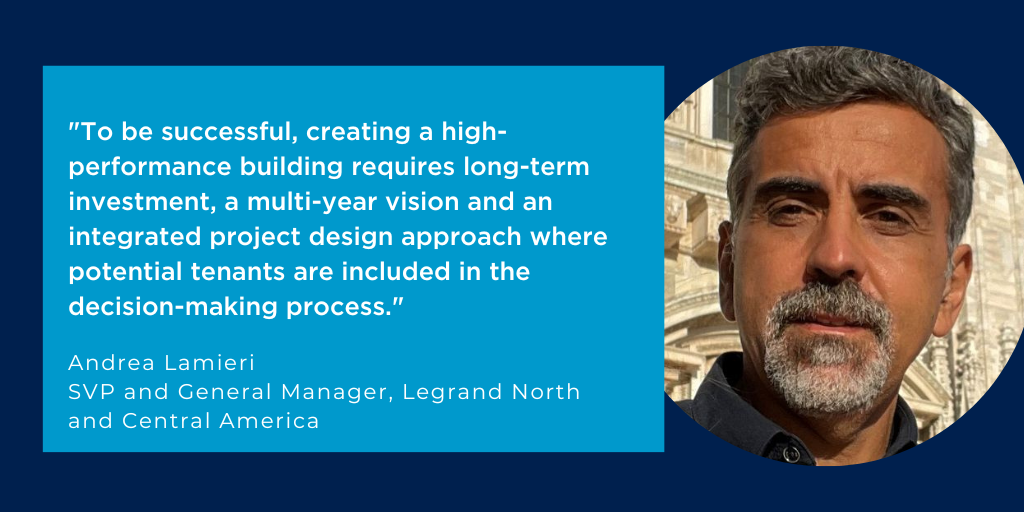
Who are you and what do you do?
Andrea Lamieri: I am the General Manager of Legrand North and Central America’s (LNCA) Building Control Systems Division – one of five divisions of LNCA. Our division offers solutions that help increase the energy efficiency, functionality and comfort of buildings through advanced lighting controls, manual and motorized shading systems, occupancy sensors and digital lighting management systems.
For those who may not be familiar with Legrand, we are a $8.7 billion company headquartered in Limoges, France. The North & Central America division is the largest division of Legrand. In total, Legrand employs more than 39,000 individuals worldwide and our products are sold in nearly 180 countries – in both commercial and residential markets. Legrand has been on its Corporate Social Responsibility (CSR) journey for more than a decade and, last year, released its fifth consecutive CSR Roadmap focusing on climate, diversity and inclusion, the circular economy and other aspects tied to being a responsible business. Last year, Legrand earned a Platinum sustainability rating from EcoVadis, the world’s most trusted provider of business sustainability ratings. This means, when it comes to sustainability, Legrand is in the top 1% of more than 75,000 evaluated companies around the world.
What are the market opportunities you see that enable you to better serve clients as demand grows for better buildings?
Lamieri: The recent pandemic gave rise to a host of opportunities to improve the energy efficiency and sustainability of new and existing buildings that not only reduce monthly energy consumption and costs but also lower the building’s annual tax burden. In addition, the rise and interworking of IoT (Internet of Things) and AI (Artificial Intelligence) enables buildings to systematically improve and futureproof themselves.
The Inflation Reduction Act (IRA) of 2022 includes incentives to build high-performing and cost-efficient spaces largely by focusing on cooling, heating, ventilation, and indoor lighting systems and controls. The IRA outlines tax deductions of up to $5 per square foot for buildings that meet energy efficiency performance requirements. It also extends tax credits of up to 30% of the cost of installing solar, geothermal and other clean technologies. This federal legislation supports the work of organizations such as the USGBC and IMT by raising the expectation of how buildings should perform, both from the perspective of owners and investors, as well as from building occupants themselves.
Stand-alone building systems are now converging into intelligent IP-based platforms that leverage integrated electrical/mechanical systems and Power over Ethernet (PoE) technology, enabling nearly every system to work together. This growing effort to digitalize and electrify buildings opens a wealth of opportunities to improve building performance. Advanced building systems now have the capability to autonomously compile and analyze massive amounts of data from IoT devices and apply learnings over time to optimize a building’s performance and environmental efficiency. Companies like Legrand are enablers that provide the physical infrastructure, advanced technology and connectivity required to support High Performance Buildings.

How are you adjusting your business model to respond to the growing wave of policies seeking to improve how buildings use energy across the U.S.?
Lamieri: One of our CSR goals is centered on helping our customers reduce their carbon footprint through the installation of energy-efficient products. This goes beyond the energy consumption of the products themselves and considers the embodied carbon related to their manufacture. To be successful, architects, contractors and building owners must be able to easily measure, compare and contrast the environmental and material profile of different products. Legrand leads the electrical industry in publishing more than 150 product transparency documents—including Environmental Product Declarations such as PEPs (Product Environmental Profiles), Health Product Declarations, and Declare labels.
Also, as we all know, these days, things are moving increasingly fast, and we have all been conditioned to expect on-the-spot responses in our times of need. To address this expectation, we’re expanding our offering to include services like advanced building automation support, remote monitoring and backup, and cloud-based computing. For example, our professionals can connect to our customers’ lighting control systems to resolve issues remotely which previously required an in-person, on-site visit. So, rather than waiting hours or days for a service visit, we can alter a building’s lighting schedules and settings from across the country in a matter of minutes, effectively reducing the building’s energy use immediately.
Are there creative ways that you are managing your supply chain and its environmental impact?
Lamieri: Legrand has set a goal to help at least 250 suppliers reduce their CO2 emissions by 30% by 2030. We understand that our suppliers are in various stages of awareness when it comes to their environmental impact, so education is a component of our strategy. For example, earlier this year, we partnered with the U.S. Department of Energy to host a multi-day Energy Treasure Hunt for our Operations teams and we invited a few of our suppliers to participate. During this event, participants learned how to identify energy savings opportunities from behavioral, operational, and maintenance actions—both when a facility is operational and when it is inactive. Going forward, the actions we and our suppliers take may be small, but we fully expect them to add up to significant energy-related savings over the coming months and years.
We have also outlined a goal to increase the diversity of our supplier base and are modeling our actions using best practices gleaned from the Billion-Dollar Roundtable (BDR). Our dimensions of diversity include minority-, women-, LGBTQIA+ and veteran-owned businesses as well as businesses that employ disabled and formerly incarcerated individuals. Supporting these types of businesses can have far-reaching benefits that may not be initially apparent. For example, supporting HUBZone-certified companies, which are located in historically underutilized business zones, not only provides stable employment opportunities and spurs local economic growth, it has also been shown to reduce crime in those areas.
What is one of the biggest challenges facing your industry when it comes to creating more resilient, higher-performing, healthier buildings?
Lamieri: The buying and design decision makers vary for every project we work on creating a wide-ranging diversity of influencers that dictate how advanced building systems contribute to the overall performance and efficiency of the facility. Energy code tends to set baseline expectations for performance and unless an owner is very motivated, we often see first cost prioritized over total cost of ownership. When it comes to investing in high performing, healthy buildings, there is also often a disconnect between the owner’s goals and the tenant’s goals leading to missed optimization opportunities. Since project designers have so many potential areas on which to focus – each requiring numerous decisions to be made, they are often challenged to prioritize where to allocate money and time to achieve the greatest impact. The time from initial design concept to tenant occupancy can also take years, resulting in another disconnect between the design intention and actual use. To be successful, creating a high-performance building requires long-term investment, a multi-year vision and an integrated project design approach where potential tenants are included in the decision-making process. There is no one-size-fits-all to building design, but the most advanced, successful projects are designed with the future in mind. The COVID-19 pandemic has made it more challenging to futureproof facilities as the outlook for real-estate, leased spaces and spatial needs remains in flux.
What industry trends are you most watching now?
Lamieri: There are several. The first is embodied carbon. The industry is expanding its focus on carbon footprint beyond just operational carbon (heating, cooling, lighting, etc.) to include the building’s embodied carbon, which considers emissions related to raw material extraction, manufacturing, transport, installation, and disposal; however, this requires a shift in thinking because the majority of these emissions occur well before the building’s construction phase. While the initial focus on reducing embodied carbon in buildings is on structural materials, Legrand is actively assessing means to reduce embodied carbon in the electrical and network systems we support in the building. By lowering the embodied carbon of our products and systems, we help our customers reduce the overall embodied carbon of their buildings.
In recent years, we have also been focusing on incorporating eco-design principles into the development of new products and are now consciously moving forward to embrace the principles of the circular economy. That simply means we are finding ways to use fewer materials and resources in the manufacture of our products, use materials and resources obtained with the least environmental impact, produce the least waste and pollution, and simplify product disassembly to make reusing and recycling easier.
The second is a focus on companies as social players. Diversity and inclusion are top of mind here. We believe a diverse workforce enables organizations to foster greater empathy for the many kinds of customers it serves. That’s why we strive to be a leading player in the area of inclusiveness, embracing and promoting all types of difference, including gender equality, social and cultural diversity, integration of people with disabilities, intergenerational collaboration, and inclusion of LGBT+ individuals.
Finally, many companies are coming to the realization that to improve building systems, we have to move away from proprietary systems and explore all the possibilities open ecosystems have to offer. We need to work with our industry partners and, at times, even our competitors, to develop innovative solutions more quickly and more effectively, with lower costs and risks. Climate change is real. The role buildings play in climate change is understood. We have no time to waste in dramatically reducing their impact on our planet.
IMT’s corporate engagement program provides financial support to IMT to serve as an ideation lab for next-generation public policies and business practices while further deploying IMT’s expertise in the building performance landscape to partners. IMT’s corporate supporters receive exclusive benefits including regular analysis on the building performance landscape and access to IMT’s market-leading expertise.
